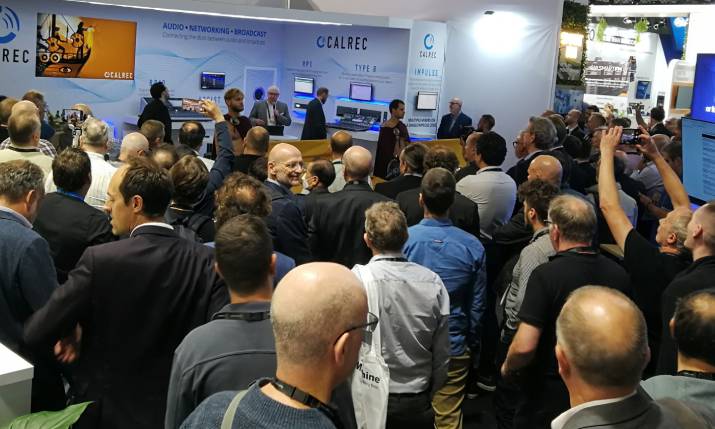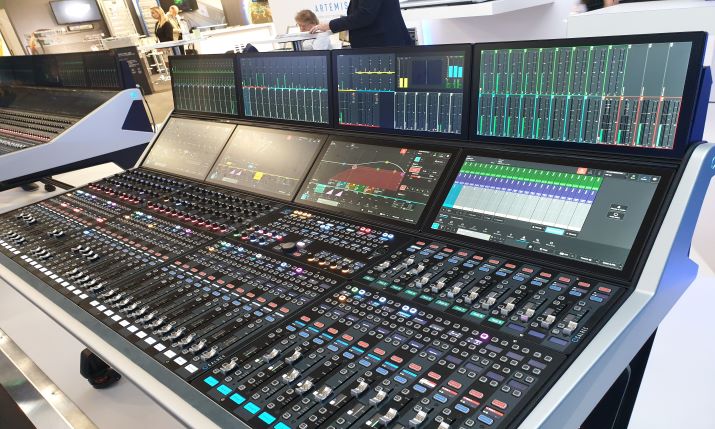Calrec announces new Argo IP audio mixing system to blend processing and control

The launch of Calrec’s Argo console at IBC 2022 drew huge crowds
At IBC 2022 Calrec Audio unveiled Argo, a brand new audio mixing system designed to keep pace with the changes broadcasters are experiencing in their production workflows. Designed to adapt to changing production needs, Calrec’s Argo is a new approach to audio mixing, with a flexible control philosophy that breaks the traditional geographic tie lines between processing and control, the company claimed.
Pete Walker, Calrec senior product manager, told SVG Europe from the show floor in Amsterdam that, “Argo is not a revolution, it’s an evolution”.
He continued: “It’s also about versatility because all broadcasters are different. Over the last few years we’ve had a lot of customer requests to do things slightly differently, that in existing infrastructures can be quite expensive and take a lot of time.
“From the beginning, we’ve tried to make Argo as versatile and flexible as possible so that when people suggest change requests they’re very easy to accommodate. It’s not just about what we have today, but about having a platform that we can build on for the future so we designed in loads of extra capabilities, not just in terms of processing power, but in the overall mechanical flexibility as well.
“We’ve tried to take all the principles that we’ve had for the last 50 years and mold them together into one desk. Argo takes the best bits from Apollo and Artemis and all the newer things that we’ve got in Brio and Type R. It’s comfortable and anybody that knows Calrec products will find their way around it.”

Calrec managed to find a couple of Argonauts especially for the launch of Argo at IBC 2022
Argo is fully modular with interchangeable hardware panels and uses Calrec’s time-served Assist UI at its core. This means that whether you are working on physical hardware panels or on a remote GUI, the user interface is both familiar and easy to drive. Its modular panel system encourages broadcasters to adapt surface hardware to meet their unique requirements, with two mid-level rows of interchangeable panels on the larger Argo Q model, and one mid-level row on the compact Argo S model.
Calrec has also introduced a comprehensive system of user templates to instantly change the hardware user interface to meet changing requirements or user preferences.
Argo is built around an expanded version of Calrec’s popular ImPulse IP core. ImPulse can also be located anywhere; the location of the control surface is not tied to the processing core. It can power up to four independent mix environments, including headless mixers accessed on the public internet, with each mixer able to access more than 2,350 processing paths on a single console; this provides enough power to deal with the biggest immersive and NGA mixing demands.
Walker continued: “The last few years have forced people to separate, to work remotely, and Argo fits perfectly into that. The traditional broadcasting template for live sports is to have a big control room or truck full of people and expensive equipment in the same place at the same time. We don’t need to do that anymore, and people are more comfortable with that.
“Everybody can work in different locations and the way Argo links to Calrec’s ImPulse core helps enable that. Every 12-fader section is fully independent in terms of power and processing, so geographic locations can completely separate.”
Argo’s physical control surface is also more streamlined, using optically bonded touchscreens to provide unrivalled visual feedback and speed of access. Soft panels provide a richer user experience and hardware panels allow users to build definable functions and apply these as templates. Calrec said this will help operators move around the surface faster and make it more intuitive.
Argo’s panels are also interchangeable and can be placed wherever they are needed. This makes it easy to grow and adapt the console to individual requirements and it means the desk can easily be split for sub mixing or mixing in other locations.
 Noted Walker: “Designing a new IP-native products can be challenging. It’s a big learning curve, for manufacturers as well as customers. You need to spend time upfront to assess all the requirements, but we are seeing customers getting more and more used to this. Broadcast engineers are now IT savvy and they’re adapting to these shifts and picking up quickly.
Noted Walker: “Designing a new IP-native products can be challenging. It’s a big learning curve, for manufacturers as well as customers. You need to spend time upfront to assess all the requirements, but we are seeing customers getting more and more used to this. Broadcast engineers are now IT savvy and they’re adapting to these shifts and picking up quickly.
“Dante is still very popular and we’re seeing a lot of mixed 2110 and Dante networks because Dante is convenient for audio operators. With 2110 you need to be a bit network focused, but it gives you a lot more power and a lot more flexibility and once it’s set up, it’s ready to go. In the early days we saw some challenges but now everything’s more stable, so products like Argo can fully exploit the benefits of an IP network,” he said.
He went on: “It’s still mostly a mix of hybrid workflows, but people are on board and they’re loving it. It’s all working. We’ve got more and more proven installations and we’re adapting all the time.”
Like all Calrec consoles, Argo builds on Calrec’s broadcast-specific surface redundancy. All control elements can be duplicated so an operator can use any panel to access inputs and controls, while fader scrolling functionality adds more protection. When combined with redundant hardware as standard, Argo provides SMTPE’s hitless packet merging alongside a second layer of hardware redundancy to guarantee broadcast uptime.
Argo includes optional AoIP IO modules which can be fitted directly into the control surface, with a variety of I/O options. These can be fitted into every section of the console to give the operator a variety of input options, make cabling more efficient and save space in external racking.
With NGA content on the increase and broadcasters adding value to productions with increasingly complex NGA output formats, Argo provides tools to make everything simpler to organize and manage. Flexible immersive spill helps maintain total control over multi-channel formats but with no need for dedicated surface real estate. Multi-channel sources can be controlled on a single fader but spilled out onto more faders for fine control; Argo allows spill faders can be placed anywhere on the control surface, on any layer and in any position to free up space and make the workspace more adaptable to individual needs.
“Argo is a testament to Calrec’s ability to innovate with the changing times and carve a path through the industry’s changing broadcast workflows. The result is an audio console that provides an unmatched feature set that meets broadcasters’ needs now and well into the future,” adds Letson.
New operational features include: Key Inputs and Ducker; full EQ and Dynamics on Auxes and Tracks; Flexible Spill; User configurable colours for faders; Control Links; Inserts on Auxes; Variable slopes on EQ shelves and filters; Flexible panel layouts (Wilds). Argo has an increased DSP engine which provides 2496 channels on a single console, and physical flexibility up to eight sections to provide up to 96 faders. Multiple sections can be combined or geographically diverse, while the enhanced ImPulse core provides enough horsepower to drive up to four Argo mix environments on one IP core.

